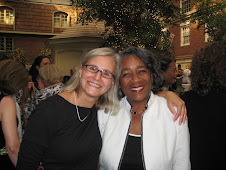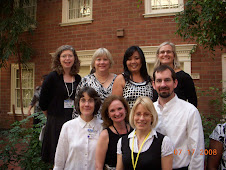Tuesday, October 7, 2008
Youth and Digital Literacy
Monday, March 17, 2008
The Bubble Map Was Just the Beginning
Here is the description of the assessment from the student direction sheet:
Goals of the assessment:
- To demonstrate a sophisticated, in-depth understanding of the relationship between character motivation and themes in The Great Gatsby.
- To apply contemporary modes of expression to this novel of the 1920s.
- To flex your creative muscles. This is your opportunity to express your ideas in a creative format.
Final Work Product:
You will create either character recipes, Facebook pages, postcard secrets, or web logs for three of the main characters in The Great Gatsby. Your creative representations of the characters should reflect in-depth analysis of each character’s development throughout the course of the novel. Consider how these characters have or have not achieved the American Dream. Make sure you do not focus all of your efforts on creativity at the expense of meaningful analysis.You must complete the following pre-writing preparation:
- Select three main characters from The Great Gatsby.
- For each character, create a bubble map with at least 10 adjectives that describe your character. Consider social, emotional, psychological and physical aspects of the character.
- In the frame, for each adjective, provide a description of events or forces from the text that help to shape the character. Include at least 5 direct passages from the novel. For longer passages you may cite the beginning phrase and last phrase of the passage along with the page number.
Next, choose one of the following options for a final product:
Option 1: Character Recipe Cards
Writing the Recipe:
For each character, create a “recipe” that combines your character traits and bakes them into your character. The list of ingredients should include the character’s traits, and baking instructions should show how the plot events help shape the character. You must use at least 5 vivid, concrete verbs in baking instructions.
Revising: Stir. Add ingredients. Checks to make sure instructions are clear and in logical order. Stir some more and check appropriateness of verbs in baking instructions. Also, proofread recipe for spelling errors. Once you have it completely right, prepare your recipe for publication.
Publication:
Write out the complete recipe on a 4 x 6 note card. Decorate the card with symbols and images appropriate for this character.
Sample Recipe: Tragic Romeo Rolls
1 cup passion
½ cup anger
5 tablespoons love
1 teaspoon regret
2 pints confusion
3 pinches of family feuding
¼ cup revenge
4 drops blood red food coloring
Directions:
Gather all ingredients. Start with passion and love and mix family feuding deep into the middle of it. Beat until well blended. Heat the ½ cup of anger until it comes to a boil. Pour into the mixture. Next add the ¼ cup of revenge and stir until clumpy. Then stir confusion throughout the mixture. Pour into baking tins. Set oven at a searing 450 degrees. Bake overnight. After baking, top with seasoned regret, stain red with food coloring.
Result: One confused, and ultimately regretful, young lover.
Serves: Two wretched families who eventually learn to eat “Tragic Romeo Rolls” and “Passionate Juliet Cobbler” peacefully together.
Option 2: Facebook pages
For each character, create a Facebook page. As you create your page for each character, remember that you are trying to show your insights into this character’s development throughout the novel. Your page should portray an accurate overall representation of what this character would do, say, or think. What are the crucial conflicts and ethical dilemmas that this character faces?
Your pages need to show careful consideration of character motivation, relationships, and conflicts. Think about elements that will highlight personality well. Also think about appropriate symbolic images that you may wish to include.
Format these appropriately, either by creating the pages online and printing them or mimicking the format in your written work.
Option 3: Character Postcard secrets
Check out the website http://www.postsecrets.com/ (Warning: There are some very provocative confessions on this website.) This is a website that allows real people to offer confessions and secrets anonymously. Your mission is to create a postcard secret for three of the main characters in The Great Gatsby. Each postcard must include images and text.
Here are the rules, as detailed on the Post Secret website: “Each secret can be a regret, hope, funny experience, unseen kindness, fantasy, belief, betrayal, desire, feeling, confession, or childhood humiliation. Reveal anything—as long as it is true and you have never shared it with anyone before.”
Create a 4 x 6 postcard but stick to one secret per card. Choose secrets that fit the characters as developed in the novel and that are appropriate for a classroom setting. Put your complete secret and image on one side of the postcard. Be brief, legible, and creative. On the back of each postcard, write a paragraph, from the perspective of the character, that explains how or why the confession of this secret is vital to your existence. Using passages from the novel would strengthen these paragraphs.
Option 4: Character Blogs
Create a blog that includes a dialogue among at least 3 of the main characters in The Great Gatsby. You should write from the first-person perspective of the characters. Your blog should include images and formatting that shows your understanding of deeper motivations and dilemmas.
Each character must offer at least two, 1-2 paragraph long entries to the blog. So, you will have at least six entries in your blog. You may pose different questions that relate to important issues throughout the book, or use the blog to allow a character to offer thoughts not revealed in Fitzgerald’s text. How might the characters react to current events of 2008?
Be creative; however, first and foremost, make sure that your entries are true to the characters’ motivations, actions, and language throughout the novel. Your blog entries may include direct passages from the text incorporated into the characters’ comments; make sure not to let these dominate the entries.
Written Reflection
Once you have created your items, you must also complete the following reflection on the creations:
Write a one to two page (typed, double-spaced) reflection that answers the following questions:
How does the creative creation for each character demonstrate an analytical perspective on the character? What thoughts or ideas are revealed through each creation? Connect these creations to specific aspects of the text, using examples and/or cited quotations as support. You may wish to consider themes revolving around the American dream, rebellion, or other significant ideas the novel raises.
Sunday, September 16, 2007
Writing in Math Class
For more information on Scott's work as the EHS Numeracy coach, visit his blog at http://www.ehsnumeracy.blogspot.com/.
Wednesday, September 12, 2007
Using Blogs
Jim Hatten has developed this website to help students get started on creating their own blogs. Jim's site is awesome, and I'm sure it will help my students when they start creating their own blogs.
If you want to link your classroom blog to this site, just let me know the URL, and I'll add it as another way to keep our learning community going.
Sunday, September 2, 2007
NUA Insights and Applications from the CoP
- NUA strategies address culture, language and cognition and require students to think about their thinking.
- NUA and Thinking Maps address classroom management by bridging the culture and achievement gaps.
- NUA provides a variety of strategies to assist students in learning with particular attention to culture, language and cognition.
- NUA strategies provide a common language to foster equity in learning that sometimes doesn't occur.
- Thinking Maps connect all disciplines to all cultures.
- I have a better grasp of NUA foundations. The research with Gifted and Talented students has mixed results since 10% of students said their writing skills declined because of Thinking Maps, but students were self reporting.
In addition, CoP members shared the following specific strategies that they plan on implementing in the classroom in the coming weeks:
- Ann will use the multi-flow map with students to discuss the causes and effects of controlling their asthma and the double bubble map to compare and contrast rescue inhalers with preventative inhalers.
- Elizabeth will implement the notebook this year to cut down on photocopying and help students get organized.
- KC, and the other English 10 teachers, are using an anticipation guide for community building in the first few days of school. KC has teacher facts on one anticipation guide. Another one English 10 will use is "High School Anticipation Guide" with questions about academic honesty and high school concerns. Many of the questions will be answered in the syllabus.
- Jim is doing his anticipation guides on surveymonkey.com and linking to his blog.
- Betsy pointed out that blogger just added the poll option so that teachers could do a weekly poll on an issue.
- Jackie has a flow map of the semester units on her bulletin board to build interest. Heidi (not a CoP member but an NUA Cohort member who shared this idea) is building a flow map across her wall as a unit progresses. Scott will consider doing this in his math class on his back white board. He could have each day's outcome summarized with a Thinking Map which flows into the next day's map summary or items learned list.
- Jackie is also adapting many of Baruti Kafele's classroom management ideas. She has a vision statement on the bulletin board, a wall of fame in back, teleflip text messaging for positive comments, student goal setting on a multi-flow map, highlighting students through their Ipods, and putting an essential question of the day and agenda on the white board each day so that students know what they are supposed to get from each day.
Text Messaging Teleflip Tip
I'm planning on getting student cell phone numbers on the first day of school, and I will try to text a few students each day. I will use text messages to remind students of missed assignments or if I need to meet with them, but mainly, I plan on using text messages as positive reinforcement for something I witnessed them doing well in class.
My husband read about teleflip in PC World, and he reminded me that sending the messages in Plain Text from Outlook will make the messages easier to read on cell phones. To get to plain text, simply click on the drop down menu where the HTML default is located on your email message.
The Star Tribune had a story on text messaging using email today, and they said how easy it is to do if you know the recipient's cell phone service provider. I guess the reporter had not heard about teleflip.com which requires no provider information. It's even easier than the Star Tribune realizes. Sometimes it pays to have a Tech Geek, PC World reading husband.
Wednesday, August 29, 2007
Technology and NUA: A Perfect Fit
Here's why . . .
- Students are engaged because they are happy to meet teachers in a communication forum very familiar to students, thereby closing the cultural gap between students and teachers.
- Students learn the ethics of the Internet and are able to police themselves.
- Students of all cultures have a voice on the blog, so students are more equal.
- Shy students have a place to express their opinions.
- Students can express opinions that they were afraid to bring up in class.
- Teachers are equipping students with a new literacy (language) for the 22nd Century.
KC West, who just finished her Master's Thesis on blogs in the classroom, stated that the current literature on the topic does not claim that the relationships transfer to face-to-face friendships. KC's article on the new literacies is being published next month, so stay tuned for more information on this topic.






